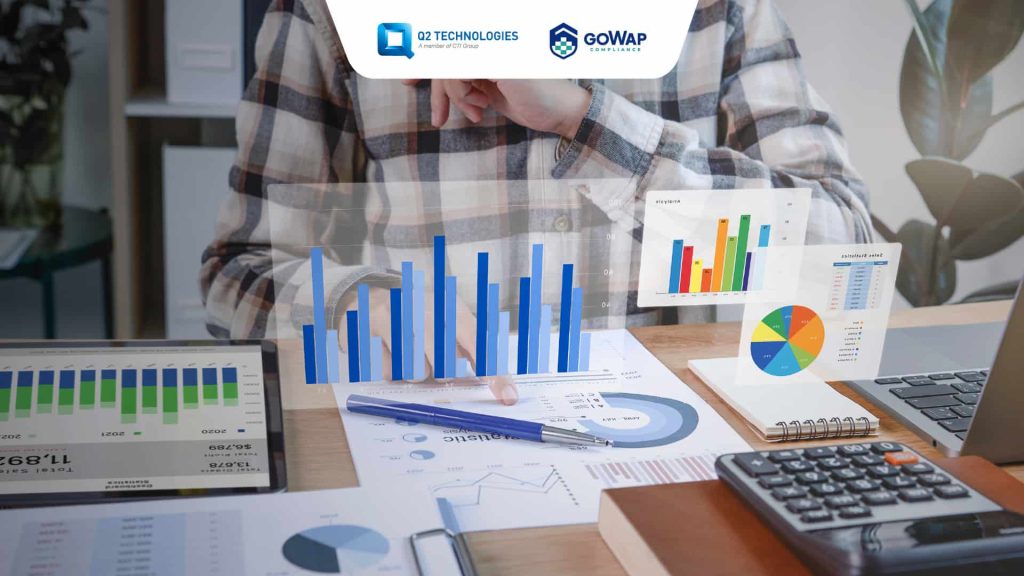In today’s fast-evolving regulatory landscape, regulatory reporting is not just about ticking compliance checkboxes—it’s a crucial tool for business transparency, risk management, and financial stability. Regulatory authorities demand accurate and timely data to monitor industries and prevent financial crises, while investors rely on transparent reports to make informed decisions and trust your organization, and businesses avoid penalties and legal risks by ensuring proper compliance with evolving regulations.
But regulatory reporting is complex—managing large datasets, keeping up with changing laws, and avoiding cybersecurity threats require a strategic approach. That’s why many companies are turning to automated regulatory reporting solutions to streamline compliance and minimize risks.
Let’s dive deeper into what regulatory reporting is, its importance, challenges, and how to optimize the process for efficiency and accuracy
What is Regulatory Reporting?

Regulatory reporting is the structured process by which organizations collect, analyze, and submit data to regulatory authorities to demonstrate compliance with legal and regulatory standards. This process ensures transparency, accountability, and adherence to industry-specific regulations, thereby fostering trust among stakeholders and maintaining the integrity of financial and operational systems.
The importance of regulatory reporting lies in its role in promoting business transparency, building trust with customers and investors, and preventing legal and economic repercussions. By providing clear and accurate information about their operations, organizations can avoid potential issues related to data concealment or mismanagement, contributing to a more open and accountable business environment.
However, regulatory reporting presents challenges, including managing vast amounts of data, navigating complex regulations, mitigating cybersecurity threats, and addressing the costs associated with compliance. To overcome these challenges, many organizations are turning to automation software to streamline data collection, analysis, and reporting processes, thereby enhancing efficiency and reducing the risk of non-compliance.
What are the Goals of Regulatory Reporting?
Regulatory reporting is the structured process by which organizations collect, verify, and submit data concerning their financial and operational activities to regulatory authorities. This practice is essential across various industries to ensure transparency, compliance, and the overall health of the financial system to achieve these goals below:
- Ensuring financial stability by submitting accurate and timely data, regulatory bodies can monitor the health of financial institutions, identify potential risks, and implement corrective measures to prevent systemic failures. This proactive approach helps maintain the stability of the financial system.
- Protecting investors with transparent reporting to keep investors about an organization’s financial status, enabling them to make informed decisions. This transparency fosters trust and confidence in the financial markets.
- Facilitating risk management to help organizations identifying and managing various risks, such as credit, market, and operational risks. By evaluating their exposure, institutions can take appropriate actions to mitigate these risks, ensuring long-term sustainability.
The Importance of Regulatory Reporting

Regulatory reporting is a critical function that promotes transparency, builds stakeholder trust, ensures compliance with legal standards, enhances operational efficiency, and supports effective risk management. Here are three reasons why regulatory reporting is important for businesses:
- Compliance with Legal Standards: Regulatory reporting is a legal requirement in many industries, ensuring that organizations adhere to laws and regulations designed to protect consumers, investors, and the market’s integrity.
- Operational Efficiency: Implementing structured regulatory reporting processes can lead to improved data management and operational efficiency, as organizations must maintain accurate records and streamline reporting procedures.
- Risk Management: Regular reporting allows organizations to identify and address potential risks proactively, contributing to better risk management and decision-making processes.
Read More: Avoiding Financial Flop: How to Get Digital Transformation in Banking Right
Types of Regulatory Reports
Regulatory reporting serves as a cornerstone for maintaining transparency, ensuring compliance, and promoting trust within the financial system. There are five types of regulatory reports:
- Financial Statements: Detailed reports outlining an organization’s financial performance, including balance sheets, income statements, and cash flow statements. These documents provide insights into the company’s profitability and financial health.
- Risk Exposure Reports: Documents that detail an organization’s exposure to various risks, such as credit, market, and operational risks. These reports help in assessing potential vulnerabilities and planning mitigation strategies.
- Transaction Reports: Records of specific transactions, including details like the nature, amount, and parties involved. These reports are crucial for monitoring compliance with regulatory requirements and detecting potential fraudulent activities.
- Compliance Reports: Reports that demonstrate an organization’s adherence to industry-specific laws and regulations. They often include information on internal policies, procedures, and any instances of non-compliance.
- Tax Reports: Documents detailing an organization’s tax liabilities and payments. Accurate tax reporting ensures compliance with tax laws and helps avoid legal penalties.
Benefits and Challenges of Regulatory Reporting
Regulatory reporting involves the systematic collection and submission of data by organizations to demonstrate compliance with legal and regulatory standards. This process is crucial for maintaining transparency, building trust with stakeholders, and avoiding legal repercussions. Not only brings benefits for businesses, regulatory reporting can also challenging.
Benefits of Regulatory Reporting
Here are the benefits of regulatory reporting for businesses:
- Ensuring Business Transparency: Regular reporting provides regulatory bodies with clear insights into an organization’s adherence to industry regulations, fostering an open and accountable environment.
- Building Trust with Customers and Investors: Demonstrating compliance through transparent reporting enhances credibility, attracting and retaining clients and investors who value ethical business practices.
- Preventing Legal and Economic Repercussions: Adhering to reporting requirements helps organizations avoid penalties, fines, and reputational damage associated with non-compliance.
Challenges of Regulatory Reporting
Regulatory reporting can be beneficial for businesses, but at the other side it can be challenging. Here are four main challenges of regulatory reporting:
- Data Management: Handling vast amounts of data requires robust systems to ensure accuracy, consistency, and timely submission.
- Complexity of Regulations: Navigating varying and evolving regulatory requirements can be challenging, increasing the risk of misinterpretation and non-compliance.
- Cost of Compliance: Allocating resources to meet reporting standards can be financially burdensome, especially for smaller organizations.
- Cybersecurity Threats: Storing and transmitting sensitive data exposes organizations to potential cyber threats, necessitating robust security measures.
How to Improve Your Regulatory Reporting Process?
Improving your regulatory reporting process is crucial for ensuring compliance, enhancing operational efficiency, and building trust with stakeholders. Here are key strategies to enhance this process:
1. Implement Automation Tools
Utilizing automation software can streamline data collection, analysis, and reporting, reducing manual errors and saving time. Automation ensures that reports are generated accurately and submitted promptly, aligning with regulatory requirements.
2. Develop a Comprehensive Data Management System
Establishing a robust data management framework is essential for accurate regulatory reporting. This includes maintaining data integrity, implementing data governance policies, and ensuring seamless data integration across departments. A well-structured system facilitates easy access to necessary information and supports timely report generation.
3. Stay Updated with Regulatory Changes
Regularly monitoring and understanding updates in regulations is vital. Assigning dedicated personnel or teams to track these changes ensures that your reporting processes remain compliant and adapt to new requirements efficiently.
4. Invest in Staff Training
Providing ongoing training for staff involved in regulatory reporting ensures they are knowledgeable about current regulations and reporting standards. Well-trained employees can effectively manage reporting tasks, identify potential issues, and implement best practices.
5. Conduct Regular Audits and Reviews
Performing periodic audits of your reporting processes helps identify inefficiencies and areas for improvement. Regular reviews ensure that data accuracy is maintained and that the reporting process aligns with organizational goals and regulatory expectations.
Regulatory Reporting Solution from GoWap Compliance
GoWap Compliance is a cutting-edge SaaS-based solution designed to simplify and accelerate transaction reporting to PPATK. By eliminating the need for complex infrastructure, maintenance, and manual updates, GoWap ensures a seamless and efficient compliance process.
Its cloud-based architecture allows businesses to stay ahead of regulatory changes without operational overhead, making it a cost-effective and scalable solution. With built-in automation, predefined business validations, and a user-friendly interface, GoWap enables organizations to streamline reporting workflows while maintaining accuracy and security.
One of GoWap’s key advantages is its ability to automate scheduled reporting, reducing manual preparation efforts and allowing compliance teams to focus on review and approval. Its parameterized configuration and predefined validations simplify setup and updates, cutting down implementation time and effort. Security is also a top priority, with complete control over user permissions and governance-aligned access policies.
The maker-checker mechanism ensures accuracy by requiring reports to be validated by two parties, minimizing the risk of errors. Furthermore, GoWap supports multiple GoAML report formats and automatically adapts to regulatory changes, keeping compliance up to date without manual intervention.
In terms of features, GoWap stands out as a fully SaaS-based platform that integrates seamlessly with existing systems, minimizing disruptions to operations. Organizations can achieve full compliance in as little as seven weeks, significantly accelerating their reporting processes.
Flexible pricing options cater to different business sizes and growth stages, and its cost-effective model eliminates implementation fees and hardware investments. By offering a fast, secure, and automated approach to regulatory reporting, GoWap empowers organizations to enhance compliance efficiency while reducing complexity and costs.
Get Your Regulatory Reporting Solution from Q2
As the ultimate solution for regulatory reporting, GoWap ensuring compliance, accuracy, and efficiency in meeting industry requirements. Get GoWap on Q2, as a trusted part of CTI Group. Q2 backed by certified and professional experts with deep industry expertise to ensure a smooth implementation and optimal performance for your regulatory reporting needs.
Don’t wait any longer! Leverage the power of GoWap today and experience a hassle-free compliance journey by contact our team now for FREE consultation.
Author: Ervina Anggraini – Content Writer CTI Group

